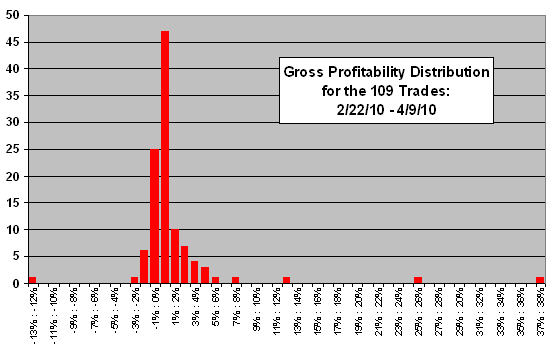A reader suggested a review of the frequent, short-term trades recorded in near real time by John Lee (WeeklyTA) via his StockTwits stream, which commenced 2/22/10. StockTwits lets users “eavesdrop on traders and investors, or contribute to the conversation and build their reputation as savvy market wizards.” John Lee offers his general trading rules in his iBankCoin blog. He has provided comments on his performance record in a separate blog. While the duration of this trading record is short, it does include many trades. These trades often have multiple partial exits. Using his stream of comments on StockTwits for 2/22/10 through 4/9/10, we find that:
In processing the data for analysis, we make the following assumptions:
- Trades are real as recorded.
- Trades are of equal size.
- A repeated purchase of a stock without selling represents a separate trade.
- Exit price is a weighted average of incremental exit prices.
- Resolve ambiguity in one complicated trade (for SOMX) by referring to linked, detailed trade data.
- Ignore a MDVN call options trade with an unclear entry price. (This trade may be a large loser percentage-wise. Large bid-ask spreads on options are problematic for short-term trading.)
- Ignore a MIL trade because the exit price is obviously wrong (indicating a 70% loss).
- Ignore 10 other trades (17 transactions) because entry/exit transactions do not match.
Residual data constitutes 109 trades (a little over three per trading day) composed of 294 transactions (an average 2.7 transactions per round-trip trade) because of scaled exits. Of these trades 102 (7) are long (short). AIG is a favorite trading vehicle (29 of the 109 trades).
Weighting incremental exits equally, the average or arithmetic mean (median) holding period for these trades is 15 (8) minutes.
The following chart displays the gross profitability distribution for all 109 trades. The average gross return per trade is 1.24%, and the median gross return per trade is 0.29%. The standard deviation of gross trade returns is 4.81%. On average, trades are profitable so long as transaction fees are less than 0.46% of trade value (1.24% average gross return per trade divided 2.7 transactions per trade).
How would excluding outliers (which may not recur reliably) affect results?

Excluding the four most extreme outcomes (one on the left of the distribution and three on the right) reduces average gross return per trade to 0.69%, with trades profitable on average so long as transaction fees are less than 0.26% per trade ($26 for a $10,000 trade but only $2.60 for a $1,000 trade).
The 12 transactions omitted from the sample as described in the assumptions above (especially the apparently unprofitable options trade) could materially affect gross return per trade.
Some trades overlap in time, so estimating a cumulative portfolio-level return would require: (1) assuming an initial total cash level; (2) determining the maximum number of concurrent positions; and, (3) setting a cash allocation rule. A requirement to have cash in reserve much of the time to fund potential trades would make portfolio-level return lower than typical trade return.
During the 34 trading days in the sample period, the S&P 500 Index rose from 1110 to 1194 (7.6%). A sample taken under different market conditions may yield different results.
In summary, evidence from simple tests on a sample of limited duration indicates that John Lee’s trades are profitable so long as trade size is reasonably large (so that transaction fees are percentage-wise small). Estimating portfolio-level performance would require additional assumptions and modeling.
Another trader trying to follow John Lee’s trades would face timing issues (substantial execution lag compared to typical holding period) and would have to set a cash allocation rule (holding cash in reserve for potential new trades).